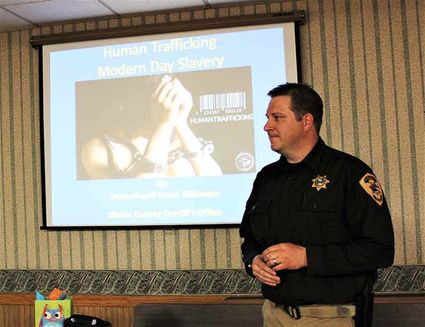Local Delta Kappa Gamma chapter hosts presentation by Undersheriff Frank Billmayer
April 4, 2018

Blaine County Undersheriff Frank Billmayer did a presentation on human trafficking to the Iota chapter of Delta Kappa Gamma. The group is made up of women educators from Blaine and Hill Counties. The chapter has seven monthly meetings during the year. Billmayer said human trafficking is the third largest criminal enterprise in the world and growing every year.
The Iota Chapter of Delta Kappa Gamma hosted a program on human trafficking presented by Blaine County Undersheriff Frank Billmayer. Delta Kappa Gamma Society International is a professional group made up of women educators. Part of the group's recent meeting was dedicated to preparing books to be given to each kindergartner in Blaine County. Presiding officer Colleen Brommer said, "Our project to provide a book to each kindergartner in the county is part of several national events that celebrate reading." She explained about 130 books had been purchased by the chapter for distribution.
The chapter asked Undersheriff Billmayer to speak on human trafficking. Billmayer opened his presentation noting, "There are more people in slavery today than anytime in human history." He added, "It's not just a function of more people in the world, human trafficking is already a global epidemic and still growing."
The global epidemic is still growing
The Undersheriff said, "Human trafficking is the third largest source of illegal income in the world, behind illegal drug sales, which is number one, and arms trafficking. Human trafficking will soon surpass arms trafficking." He added, "It's all about money. Human trafficking is a $9 billion dollar a year enterprise globally. Estimates are that 27 million people are held against their will in some sort of bondage." "Unlike a one-time drug sale," he added, "human trafficking resources are reusable. Criminals continue to abuse their victims time and time again. The reusable aspect of human trafficking appeals to criminals."

While sex trafficking is a major part of the global crime, it's not the only type of human trafficking. Large numbers of victims are recruited and held as laborers, varying from agricultural jobs to positions in factories. Others are in debt bondage, forced to work as captives because they can't pay off a debt. And a growing segment of this illicit business is organ harvesting, with victims sometimes left to die once a marketable organ is removed from them.
Billmayer cited some statistics to describe the extent of human trafficking in the U.S. and Montana. He said, "In the U.S. it's estimated that about 20,000 adults are sex victims of trafficking each year. About 100,000 children are caught up in the sex trade annually." In Montana human trafficking crimes are on an uptick. Billmayer added, "I believe the numbers will grow as the public and law enforcement look closer for the problem."
Some countries have no laws or minimal regulations to stop human trafficking. Billmayer showed a world map that indicated the level of regulation around the world. An accompanying graphic shows the countries where victims were initially taken or recruited. Most of the victims end up in the U.S. or a few Asian countries.
Indicators of a potential
human trafficking situation
Many people victimized by human trafficking are already vulnerable-teenaged runaways, prostitutes who've severed communication with families and other marginalized groups that are on their own. Billmayer said a lot of the recruiting or taking of victims happens through social media, especially with teens. He talked about "the nexus" between human trafficking and predators looking for victims on the internet.
As a member of the Montana Internet Crimes Against Children (ICAC) Task Force, a statewide group of trained law officers who deal with victimizing of children via the internet, Billmayer cited numbers of examples
of kids who were lured into meeting someone face-to-face via social media. That's often the first step to moving a youngster into a "life of hell." Often these victims are uncooperative with law enforcement because they fear consequences from the people who control them.
Actions the public can take to help stop human trafficking
Billmayer described "pre-indicators" that can suggest someone is vulnerable to a predator with some kind of trafficking in mind. For parents, he said, "Be mindful of changes, especially in teenagers' behavior. If they are associating with unknown persons, especially on the internet, this can be a sign they are being lured by a predator." Teens posting sexual online profiles or photos and 'sexting' (sending or posting sexually suggestive messages) can be precursors to being lured by a perceived glamorous life or escape from rules at home.
Some signs of potential human trafficking are recognizable. Older, age inappropriate men in the company of more than one younger girl can suggest some sort of a controlling situation. People caught up in a bondage situation may be traveling very light, have no idea of where they are going and the controlling adult my have all their identity papers. A new trend among pimps is to brand or tattoo their victims to show ownership. Minors hanging around places not normally frequented by teens, like a truck stop, and wearing revealing clothing could all be signs of a trafficking situation.
Billmayer said, "Often a tip by the public can alert law enforcement to a human trafficking situation. If you see some of the situations mentioned above, contact a police officer with a license plate number, vehicle description or a description of the people involved. Do not approach these people, they can be very dangerous." The Undersheriff went on to explain that often a citizen's alert can begin the process of intervening in a human trafficking situation.
This is the third time Billmayer has presented to groups about human trafficking. He said, "I'm pleased there is more public recognition of the problem." In other presentations he does about predators on the internet, he describes various techniques predators will use to lure unsuspecting victims, especially children.

